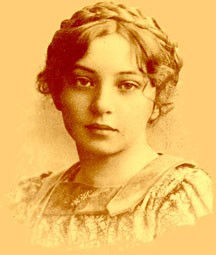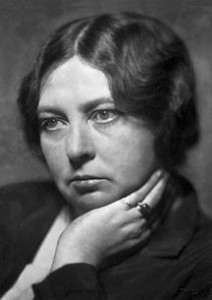Your Next Door County Read
- Share
- Tweet
- Pin
- Share

Sigrid Undset is as captivating a figure as the heroine of her novels. She wrote Kristin Lavransdatter in 1920 – after the loss of her father, a decade of secretarial work, a few years abroad in Italy, a passionate but failed marriage to a painter she met there, three children, and already significant literary success. Undset poured her knowledge from the various stages of these 38 years into Kristin’s story.
“It is absurd,” Robert Frost once scoffed, “to think that the only way to tell if a poem is lasting is to see if it lasts.” Rather, he declared, “The right reader of a good poem can tell the moment it strikes him that he has taken an immortal wound – that he will not get over it.” The same must be true of literature in general, because recently I received such wounds from three novels — a trilogy by Sigrid Undset referred to collectively as Kristin Lavransdatter.
In these books — The Wreath, The Wife, and The Cross – Undset chronicles the life of a 14th century Norwegian noblewoman from girlhood through death. If this sounds like a dull drag to you, keep reading: after witnessing it rivet college boys and bring old women to tears, I have marked it as one of the most universally appealing books of the modern era. Why? Because, like all great literature, this story is chock-full of humanity’s depths and breadths, all woven together into one harmonious narrative, with characters you grow to love like real people.
Kristin’s beginnings with her devout, distinguished parents are happy, yet we also learn straightaway of troubles biding below the surface and around the corner. The main drama of the novel comes when Kristin meets an out-of-favor knight named Erlend; of course, though already betrothed to a good man, she falls in love with him and into sin. After a long struggle, they do marry and through many difficulties, their passion endures. Undset is no sentimentalist: she penetratingly observes the sorrows that can arise from such a pairing. Neither, however, is she a cynic: the reader is also privileged to share with Kristin all the sweetness of her years as a wife, mother to eight sons, and mistress of an estate. Finally, the book’s end is one of the single most satisfying I have ever read, leaving you with no possible concern that Kristin’s vices went without redemption or virtues without reward.

Young Sigrid Undset.
The personal drama is mirrored in the novel by the political and religious dramas of medieval Norway, and the story itself thoroughly steeped in Scandinavian culture, which is part of what makes Kristin Lavransdatter particularly appropriate for our own Norse-saturated peninsula. As a child Undset explored medieval manors with her archeologist father; later as a young secretary, she devoted much of her free-time to researching the medieval era. It’s no wonder that upon publishing these novels, Undset was lauded for their historical and ethnological accuracy – an achievement that was crucial in her selection for the Nobel Prize later on.
Here is another reason why it is good for a Door County visit, when you’re inevitably people-watching as well as page-turning while you sit on the beach or outside a coffee shop – like most classics, Kristin Lavransdatter is gracefully written, but it is also surprisingly easy to read. Far from the wordy, winding prose of Victorian authors, Undset’s style was highly influenced by the old Scandinavian sagas which she first read as a child: it is clear, simple, and direct. Oftentimes, especially in the dialogue and depictions of her characters, she implies much with few words. To most of us, this typically Northern terseness is not unfamiliar.

Sigrid Undset.
But Undset departs from the traditional saga style too. Unlike her predecessors, she often grants us vivid descriptions of the natural world, writing about a spring scene: “Thin tendrils of water shone on the mountain slope,” “[t]he heat steamed and trembled over the land,” and “the grass in the meadows grew deep and shimmered like silk when the wind blew across it.” Surrounded by beautiful landscapes as we are in this county, we understand intimately how one’s environment sets the stage of life, and Undset’s eloquent accounts certainly conjure up a powerful mood. Frequently in the novel, nature contributes even more to the narrative, either by foreshadowing future action or reflecting characters’ interior states. An example of the latter comes when a long, harsh winter accompanies a similarly long stalemate between Kristin and her father, Lavrans, who has refused to receive Erlend as a suitor; eventually, Lavrans invites her outside to watch the ice breaking up on the river at last, and it is then that he finally agrees to meet with Erlend.
Undset’s skillfully crafted story makes for an ever-compelling tale, yet her calm style of storytelling and her truly human characters make returning to its pages like returning to an old friend. Also, because of its intimately biographical quality, the more you’ve lived, the more her story offers you. Every older man or woman I meet who has read it gives the same advice – “Go back to it when you’ve married, when you have children, when you become a grandmother.” I knew very quickly after I started The Wreath that I would be taking their advice. As Robert Frost said of poetry, so it is with this trilogy: the “proof” of Kristin Lavransdatter is not that I have never forgotten it, but that I knew, right from the beginning, I never could forget it.

